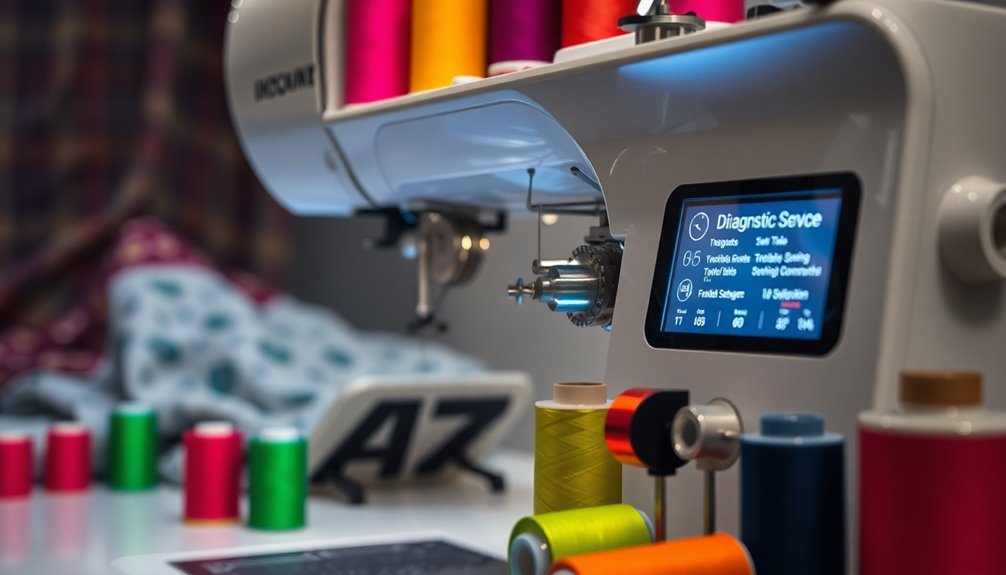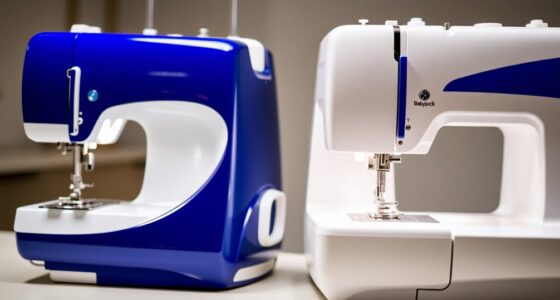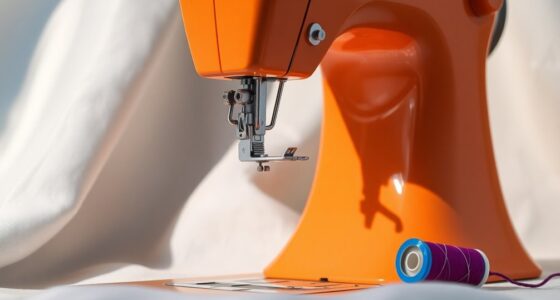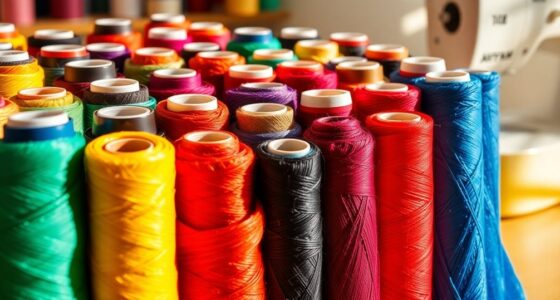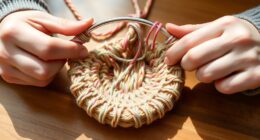If your sewing machine's acting up, don't panic! First, check for thread breakage and verify proper threading with quality thread. For skipped stitches, replace dull needles and use the right type for your fabric. Adjust the tension dial around 4.5 for cottons and clean out any lint or dust to prevent jams. Regular maintenance like needle replacement and proper storage is key to smooth operation. Stick around to uncover more tips for seamless sewing!
Key Takeaways
- Ensure proper threading by verifying the upper thread path and bobbin insertion, with the presser foot raised during threading to enhance performance.
- Use high-quality thread to minimize breakage and improve stitch quality; regularly check and replace dull or bent needles.
- Adjust the upper tension dial around 4.5 for cotton fabrics, testing on scrap fabric to achieve balanced stitches.
- Regularly clean lint and dust from the bobbin area and feed dogs; lubricate moving parts as per the sewing machine manual.
- Store your sewing machine in a dust-free environment and use a cover to protect it from dust and debris.
Common Sewing Machine Issues and Their Solutions
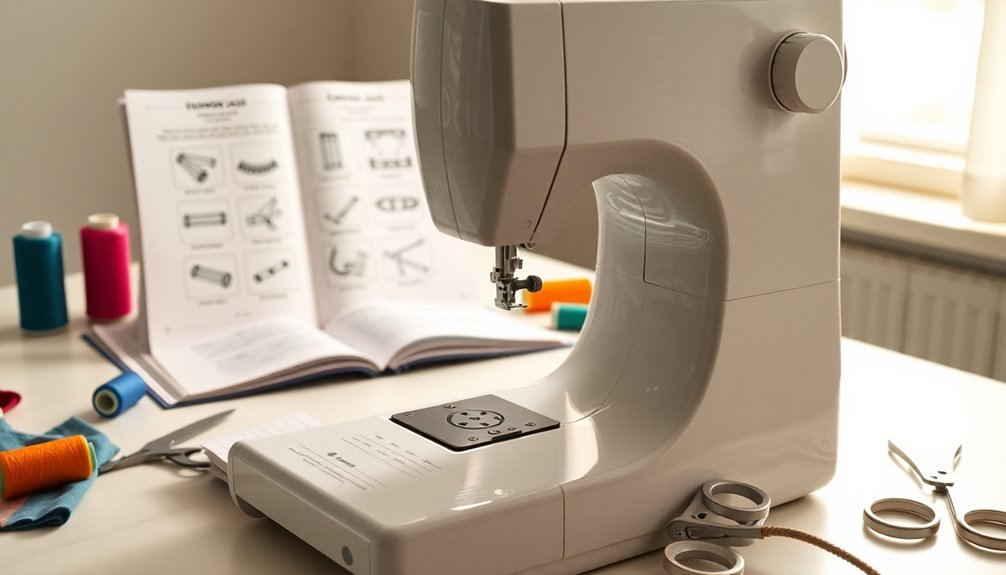
When you're sewing, encountering common issues can be frustrating, but many problems have straightforward solutions.
Thread breakage often stems from improper threading, low-quality thread, or a dull needle, so rethread and inspect your needle's condition.
If you find yourself dealing with skipped stitches, check your needle type and size, replacing it if bent.
Tension issues can lead to uneven stitching; adjust your tension dial to around 5 for most cottons and experiment as needed.
Thread bunching occurs when the upper thread isn't threaded correctly or the presser foot isn't lowered, so verify proper threading and foot position.
Finally, mechanical issues that cause fabric ingestion may be due to jammed bobbin cases or incorrect presser foot pressure—regular sewing machine maintenance can help!
Understanding Thread-Related Problems

While sewing, understanding thread-related problems is vital for maintaining smooth operation and achieving high-quality results. Thread breakage often results from improper threading, using low-quality thread, or the wrong needle size. To resolve issues like thread bunching, verify the upper thread is threaded correctly through all tension discs and that the bobbin is inserted properly. Adjusting the tension settings, usually around 4.5 for most fabrics, is important for balanced stitches. Rethreading your machine with the presser foot raised helps the thread seat properly in the tension discs, enhancing stitch quality.
| Problem | Solution |
|---|---|
| Thread Breakage | Use high-quality thread |
| Improper Threading | Rethread with foot raised |
| Incorrect Needle Size | Use the correct size |
| Tension Issues | Adjust tension settings |
Troubleshooting Needle-Related Issues
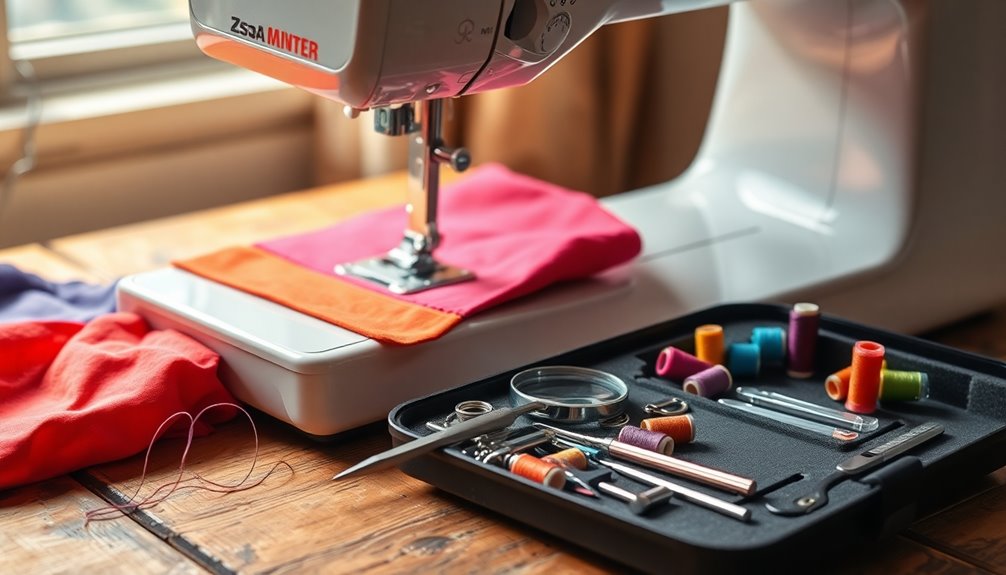
When you're facing sewing challenges, needle-related issues are often the culprit.
It's essential to understand the right needle types and how to insert them properly to avoid problems like skipped stitches.
Let's explore common needle problems and how to tackle them effectively.
Identifying Needle Types
Understanding needle types is vital for effective sewing and can prevent many common issues you might face.
Different needle types serve specific purposes: use a ballpoint needle for knits, universal needles for woven fabrics, and quilting needles when working with multiple layers.
Needle sizes also matter; larger numbers indicate thicker needles suitable for heavier materials. A bent or dull needle can lead to skipped stitches, fabric damage, and thread breakage, so replace them regularly.
Always guarantee the flat side of the needle faces the back of the sewing machine for proper alignment.
Matching the needle type and size with your fabric and thread is essential for achieving ideal stitch quality and avoiding sewing problems.
Needle Insertion Techniques
Proper needle insertion is vital for smooth sewing and avoiding common issues. Start by verifying your sewing machine needle is inserted with the flat side facing the back, assuring proper positioning.
Always push the needle fully into the needle clamp to prevent skipping stitches and guarantee peak stitching quality. Regularly check for needle dullness; replacing needles after each project or at signs of bending will help maintain performance.
It's important to select the correct needle size and type for the fabric you're using, as the wrong choice can lead to fabric damage or skipped stitches.
Finally, tighten the needle clamp securely after insertion to avoid any loosening during operation, which could disrupt your sewing.
Common Needle Problems**
Even with correct needle insertion, you might still encounter issues that can disrupt your sewing experience. Skipped stitches often stem from a dull or bent needle, so check and replace your needles regularly.
Make certain you're using the appropriate needle type for your fabric; for example, a ballpoint needle works best for knits, while a sharp needle is ideal for woven fabrics.
Improper needle installation can also cause problems, so verify the flat side faces the back. Needle breakage can happen when you push or pull fabric; let the feed dogs do their job.
Finally, cleaning the machine of lint or debris is essential for effective sewing machine maintenance and helps prevent needle-related problems.
Tension Adjustments for Optimal Stitch Quality
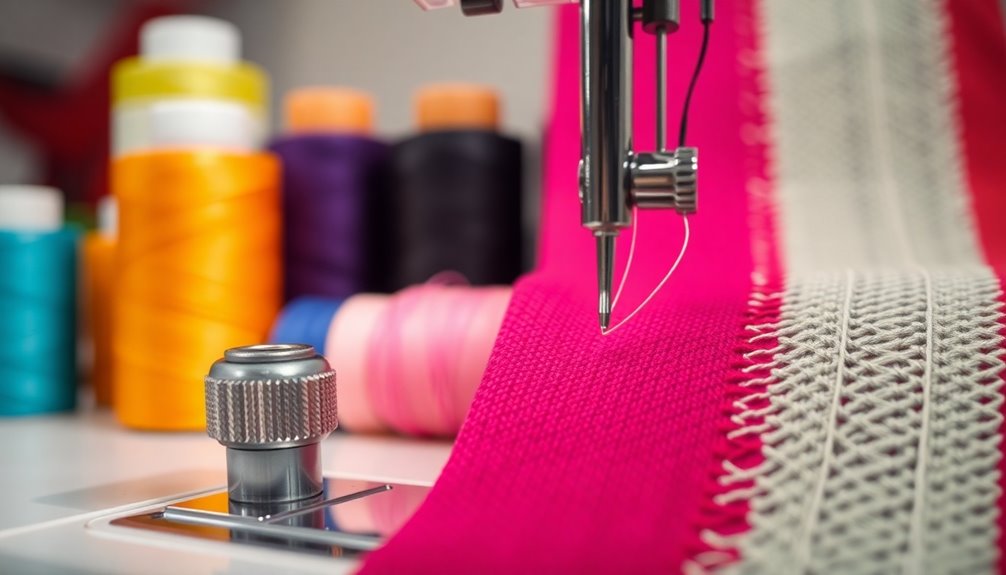
When you're aiming for ideal stitch quality, adjusting the tension on your sewing machine is key.
Start by setting the upper tension around 4.5 for most cotton fabrics, but be ready to modify it based on thickness and stretchiness.
Always thread your machine with the presser foot in the up position to guarantee the thread seats properly in the tension discs, vital for balanced stitch formation.
After making adjustments, conduct tests on scrap fabric to gauge peak stitch quality.
Keep a record of your tension adjustments and results for future reference.
Regularly check and clean the tension discs to prevent lint buildup, which can disrupt tension accuracy and lead to inconsistent stitching, especially with varying yarn types.
Addressing Mechanical Malfunctions
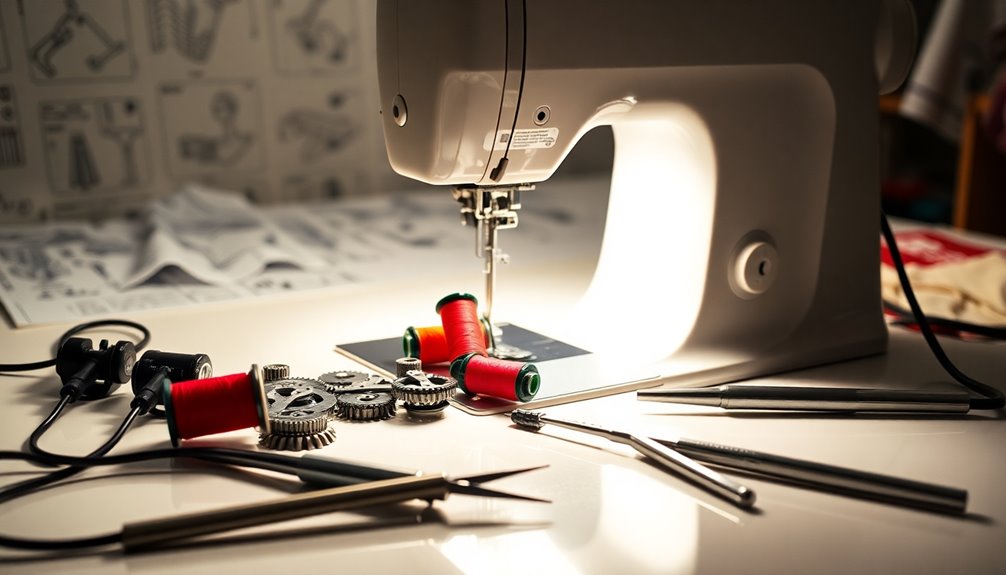
While tension adjustments can considerably improve stitch quality, mechanical malfunctions can derail your sewing projects entirely. Issues like a jammed bobbin or misaligned feed dogs require immediate attention. Regular maintenance, including cleaning your machine and oiling it, can help prevent these problems. If you hear unusual noises or face constant thread breakages, it's a sign of deeper issues that may need professional repair.
| Issue | Solution |
|---|---|
| Jammed Bobbin | Inspect the needle |
| Misaligned Feed Dogs | Check and adjust alignment |
| Worn Components | Consider sewing machine repair |
| Unusual Noises | Schedule proper servicing |
| Thread Breakages | guarantee regular maintenance |
Keeping a record of repairs aids in efficient diagnostics. Don't hesitate to consult professionals for persistent issues.
Preventive Maintenance Tips for Your Sewing Machine
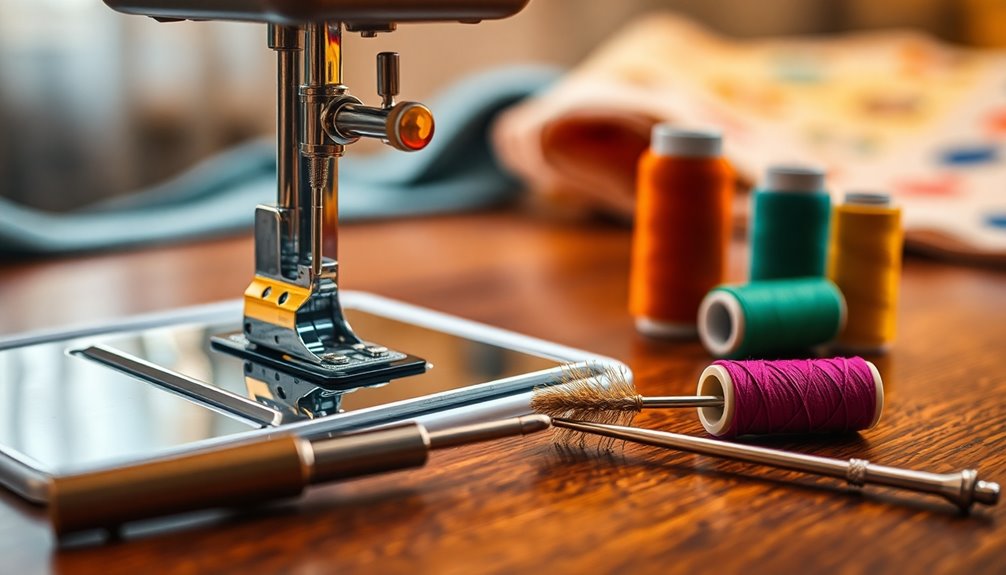
Keeping your sewing machine in top shape is essential for smooth and enjoyable sewing experiences. Start with regular sewing machine maintenance; clean your sewing machine by removing lint and dust from the feed dogs and bobbin area to prevent jamming.
Lubricate moving parts according to your sewing machine manual, typically every few months, to maintain peak performance. Remember to replace needles frequently—ideally for every new project—to avoid complications like skipped stitches.
Always follow correct threading procedures, ensuring the presser foot is up during threading for proper tension.
Finally, store your machine in a dry, dust-free environment, and use a dust cover to protect it from debris and moisture, helping to prevent rust and mechanical issues.
Frequently Asked Questions
What Is the Number One Problem When a Machine Doesn't Sew Properly?
When your sewing machine doesn't sew properly, the number one issue is often incorrect threading.
You've got to make certain the machine's threaded with the presser foot up to guarantee proper seating. This simple step can prevent tension problems, skipped stitches, and thread bunching.
Regularly check the needle for dullness or bends, as these can also lead to sewing issues.
Taking these precautions can help you achieve smooth, consistent stitching.
What Is the Common Sewing Machine Trouble?
Imagine threading your machine, the fabric gliding smoothly, when suddenly it stutters—frustration mounts.
Common sewing machine troubles often include thread breakage, skipped stitches, and uneven stitching. You might find yourself grappling with tension issues or messy thread bunching.
Fabric feeding problems can arise too, especially if you haven't adjusted your presser foot correctly.
Regular maintenance and checks can help you transform your sewing experience from a battle into a blissful creation.
Why Does My Sewing Machine Keep Jamming Underneath?
Your sewing machine might keep jamming underneath due to several issues.
First, check if the thread is properly threaded; improper threading can cause nesting. A bent needle or insufficient bobbin thread length can also lead to jams.
Dust and lint buildup might be obstructing movement, so clean the bobbin area regularly.
Finally, make certain you're using quality thread compatible with your fabric and adjust the tension settings to minimize jams.
Why Did My Sewing Machine Suddenly Stop Working?
So, your sewing machine's decided to take a break, huh? It's either on strike or just a tad dramatic.
First, check if it's plugged in—machines love power! Look for thread jams and inspect that needle; it can't sew if it's broken.
Make sure you threaded it properly; your presser foot might be down, causing a tantrum.
If all else fails, it might need a professional intervention.
Conclusion
In the world of sewing, your machine is like a trusty compass guiding you through creativity. When it falters, remember it's just a signpost on your journey, not the end of the road. By understanding the common issues and solutions outlined in this guide, you'll restore your machine's rhythm and keep your projects flowing smoothly. With a little care and attention, you'll transform challenges into stepping stones, ensuring your sewing adventure never loses its direction.
